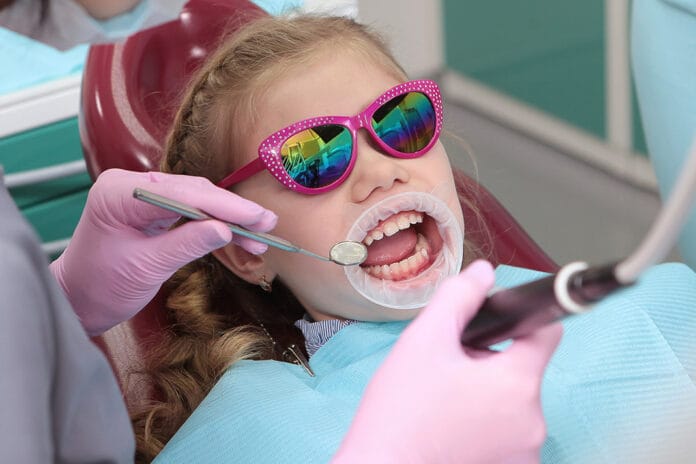Disclosure: This article is sponsored content from LISTERINE® as part of our sponsored partner program.
Early childhood caries (ECC) is one of the most common chronic diseases in children. Community water fluoridation has been considered one of the best interventions in the prevention of ECC over the past 78 years. The anniversary of the first town to have water fluoridation, Grand Rapids, Michigan, is January 25th, bringing the total years of water fluoridation to 78 in 2023.1
Even with water fluoridation, the prevalence of childhood caries in youth (age 2-19 years) is around 45.8%, leaving much room for improvement in prevention strategies.2 ECC is defined by the American Academy of Pediatric Dentistry as “the presence of one or more decayed (non-cavitated or cavitated lesions), missing (due to caries), or filled tooth surfaces in any primary tooth in a child 71 months of age or younger.”3
The etiology is complex as it is multifactorial, with home care, diet, the composition of the oral microbiome, and salivary composition all contributing to disease onset and progression.4 It has been well established that S. mutans (one of the bacteria associated with ECC) is vertically transmitted within families, with the mother being the primary source of transmission.5 However, studies have also confirmed horizontal transmission (transmission between nonfamily members) among school-aged children who are not related.6
ECC is a public health concern as socioeconomic status is the strongest influencing factor. Though many people argue that the U.S. health care system may be to blame, this is not a U.S.-centric problem. There is evidence this is true even in countries that provide free dental care. With coverage for preventive and restorative care, evidence indicates low socioeconomic status is still a huge influence on the rate and risk of ECC.8
Manifestations
ECC manifestations vary and can be quite hard to detect by a layperson. It is commonly believed that “baby teeth” are not important. However, this is a misunderstanding among many parents, as primary teeth are essential for nutrition, development, speech, and self-esteem. When left untreated, ECC manifestations can be much more serious and even life-threatening.9 There are incidents of sepsis, respiratory obstruction, descending necrotizing mediastinitis, Lemierre’s syndrome, cervical necrotizing fasciitis, orbital abscess, cavernous sinus thrombosis, brain abscess, and osteomyelitis documented as the result of untreated caries.9
Treating ECC early is imperative for a child’s health and will leave less of a dent in the parent or caregiver’s wallet. When caught and treated early, the cost is significantly less, and the experience is much less traumatic for the child as well as the parent. Another aspect to consider regarding financial concerns is that some of the costs of hospitalizations associated with late-stage ECC and some of the more serious, life-threatening manifestations will fall on taxpayers. This makes ECC a public health problem, not an individual problem.
Prevention Strategies
Many prevention strategies have been implemented through the years. One of the 10 great public health achievements of the 20th century is community water fluoridation. It is estimated that it has reduced the incidence of tooth decay by about 25%. With over 75 years of research on safety and benefits, community water fluoridation is one of ECC’s best and most cost-effective prevention strategies. Additionally, community water fluoridation is often the only prevention strategy some children will receive, considering the high risk of incidence of ECC in low socioeconomic classes.10
Though a great intervention, oral health literacy is underutilized due to a lack of community dental programs. Bridging the gap between medicine and dentistry would be essential in improving oral health literacy. Providing information and education regarding oral health at prenatal and postnatal visits with OBGYNs, as well as at pediatric well-child visits, has the potential to reduce the incidence of ECC.
Simple strategies could be addressed at pediatric well-child visits, including:
- Limiting fermentable carbohydrate intake
- No bottle/sippy cup before bed at night (unless it is water only)
- Limiting bottles/sippy cups with juice
- Ensuring all children see the dentist no later than age one or the eruption of the first tooth (whichever occurs first)
Once a child is established in a dental office and has regular dental visits, many in-office prevention strategies exist to manage and prevent ECC. Radiographs are an essential tool in diagnosing dental decay. Though they can be a little uncomfortable for small children, they are necessary, and skipping them is not a good option.
Sealants are cost-effective and reduce the incidence of dental decay in chewing surfaces of teeth by greater than 80% for up to two years after placement. It is essential to check sealants and ensure they are properly sealed without chipping to maintain this level of prevention. (Parents, ask your child’s hygienist to check the integrity of their sealants at every dental checkup.) It is estimated that the average cost of placing a sealant is one-third the cost of restoring a single area of dental decay.11,12
A subset of the population believes fluoride could be detrimental to health, even though we have almost 100 years of science-based research that states otherwise. It is important to understand fluoride is naturally occurring in many foods, beverages, and the water we consume. This is considered systemic fluoride exposure; it isn’t the same as topical exposure. Systemic exposure, though, can provide some topical benefits in that the fluoride is released in crevicular fluid.13 This is an important distinction to understand, especially if you are on the fence about using fluoride as a prevention strategy in the development of ECC.
Professionally applied fluoride varnish reduces the incidence of new decay in school-aged children by about 37%.14,15 Topical fluoride exposure also occurs through toothpaste and mouth rinses. These are not meant to be ingested; they are for application directly to the teeth. Topically applied fluoride sources are not well absorbed through the oral mucosa and generally account for only 1% of daily exposure.16,17 Any excess fluoride that makes its way into the body is quickly metabolized and excreted through the urine.18 Therefore, the contribution of topically applied fluoride sources does not significantly increase the burden of fluoride found in the body.18
However, avoiding fluoridated toothpaste and mouth rinse can and does affect oral health, which can then cause detrimental health effects down the road. Though many oral health products are made for children, including a fluoridated mouth rinse in a child’s at-home oral hygiene routine can help with the prevention of ECC.
Accepted by the American Dental Association (ADA), LISTERINE® SMART RINSE® is an option of a fluoridated mouth rinse to add to oral home care routines for preventing ECC. It was developed and is recommended for children six and older. LISTERINE® SMART RINSE® comes in a variety of fun flavors, with Bubble Blast flavor being voted 2022 Product of the Year in the Oral Care category in a survey of 40,000 shoppers. It is alcohol-free and tints food particles and debris to help children and their parents brush and clean interdentally more effectively. As with using disclosing solution in-office, a mouth rinse that tints food particles and debris can help ensure thorough removal and is a great visual for children and parents alike.
Conclusion
Combined, good hygiene at home (including fluoridated toothpaste, interdental cleaning, and mouth rinse), regular dental visits, better oral health literacy, and public health interventions, such as school sealant programs and community water fluoridation, significantly reduce the incidence of ECC.
It is important for dental professionals to be educated on prevention strategies and the risks of ECC if left untreated, so they can better educate soon-to-be parents, parents, caretakers, and children. Preventive in-office strategies and recommending preventive at-home strategies, such as LISTERINE® SMART RINSE® as an adjunct to brushing and interdental cleaning, can help in the ongoing battle of incidence of ECC. Implementing a range of strategies can increase oral health literacy and provide better overall protection to children at increased risk of developing ECC.
To learn more about LISTERINE® SMART RINSE®, click here.
References
- Mullen, J. History of Water Fluoridation. British Dental Journal. 2005; 199(Suppl 7): 1-4. https://doi.org/10.1038/sj.bdj.4812863
- Fleming, E., Afful, J. (2018, July 25). Prevalence of Total and Untreated Dental Caries Among Youth: United States, 2015-2016 [NCHS Data Brief No. 307]. Centers for Disease Control and Prevention. https://www.cdc.gov/nchs/products/databriefs/db307.htm
- Definition of Early Childhood Caries (ECC). (2008). American Academy of Pediatric Dentistry. https://www.aapd.org/assets/1/7/d_ecc.pdf
- Anil, S., Anand, P.S. Early Childhood Caries: Prevalence, Risk Factors, and Prevention. Frontiers in Pediatrics. 2017; 5: 157. https://doi.org/10.3389/fped.2017.00157.
- Binks, C., Duane, B. Mother-to-child Transmission of Streptococcus mutans. Evidence-based Dentistry. 2015; 16: 39-40. https://doi.org/10.1038/sj.ebd.6401089
- Doméjean, S., Zhan, L., DenBesten, P.K., et al. Horizontal Transmission of Mutans Streptococci in Children. Journal of Dental Research. 2010; 89(1): 51-55. https://doi.org/10.1177/0022034509353400
- Knoblauch, U., Ritschel, G., Weidner, K., et al. The Association between Socioeconomic Status, Psychopathological Symptom Burden in Mothers, and Early Childhood Caries of Their Children. PloS One. 2019; 14(10): e0224509. https://doi.org/10.1371/journal.pone.0224509
- Verlinden, D.A., Reijneveld, S.A., Lanting, C.I., et al. Socio-economic Inequality in Oral Health in Childhood to Young Adulthood, Despite Full Dental Coverage. European Journal of Oral Sciences. 2019; 127(3): 248-253. https://doi.org/10.1111/eos.12609
- Bali, R.K., Sharma, P., Gaba, S., et al. A Review of Complications of Odontogenic Infections. National Journal of Maxillofacial Surgery. 2015; 6(2): 136-143. https://doi.org/10.4103/0975-5950.183867
- Community Water Fluoridation. (2020, January 15). Centers for Disease Control and Prevention. https://www.cdc.gov/fluoridation/index.html
- Griffin, S.O., Wei, L., Gooch, B.F., et al. Vital Signs: Dental Sealant Use and Untreated Tooth Decay Among U.S. School-Aged Children. Centers for Disease Control and Prevention, Morbidity and Mortality Weekly Report (MMWR). 2016; 65(41); 1141-1145. https://www.cdc.gov/mmwr/volumes/65/wr/mm6541e1.htm
- The State of Dental Health: School Years and Beyond. (n.d.). Children’s Dental Health Project. https://www.cdhp.org/state-of-dental-health/schoolandbeyond
- Fluoride: Topical and Systemic Supplements. (2021, July 15). American Dental Association. fluoride-topical-and-systemic-supplements
- Horst, J.A., Tanzer, J.M., Milgrom, P.M. Fluorides and Other Preventive Strategies for Tooth Decay. Dental Clinics of North America. 2018; 62(2): 207-234. https://doi.org/10.1016/j.cden.2017.11.003
- Marinho, V.C.C., Worthington, H.V., Walsh, T., Clarkson, J.E. Fluoride Varnishes for Preventing Dental Caries in Children and Adolescents. The Cochrane Database of Systematic Reviews, John Wiley & Sons. 2013; 7: CD002279. https://doi.org/10.1002/14651858.CD002279.pub2
- Twetman, S., Stecksén-Blicks, C. Urinary Fluoride Excretion after a Single Application of Fluoride Varnish in Preschool Children. Oral Health and Preventive Dentistry. 2018; 16(4): 351-354. https://doi.org/10.3290/j.ohpd.a40959
- O’Mullane, D.M., Baez, R.J., Jones, S., et al. (2016). Fluoride and Oral Health. Community Dental Health. 2016; 33(2): 69-99. https://www.cdhjournal.org/issues/33-2-june-2016/704-fluoride-and-oral-health?downloadarticle=download
- Martínez-Mier, E.A. Fluoride: Its Metabolism, Toxicity, and Role in Dental Health. Journal of Evidence-Based Complementary & Alternative Medicine. 2012; 17(1): 28-32. https://journals.sagepub.com/doi/10.1177/2156587211428076










